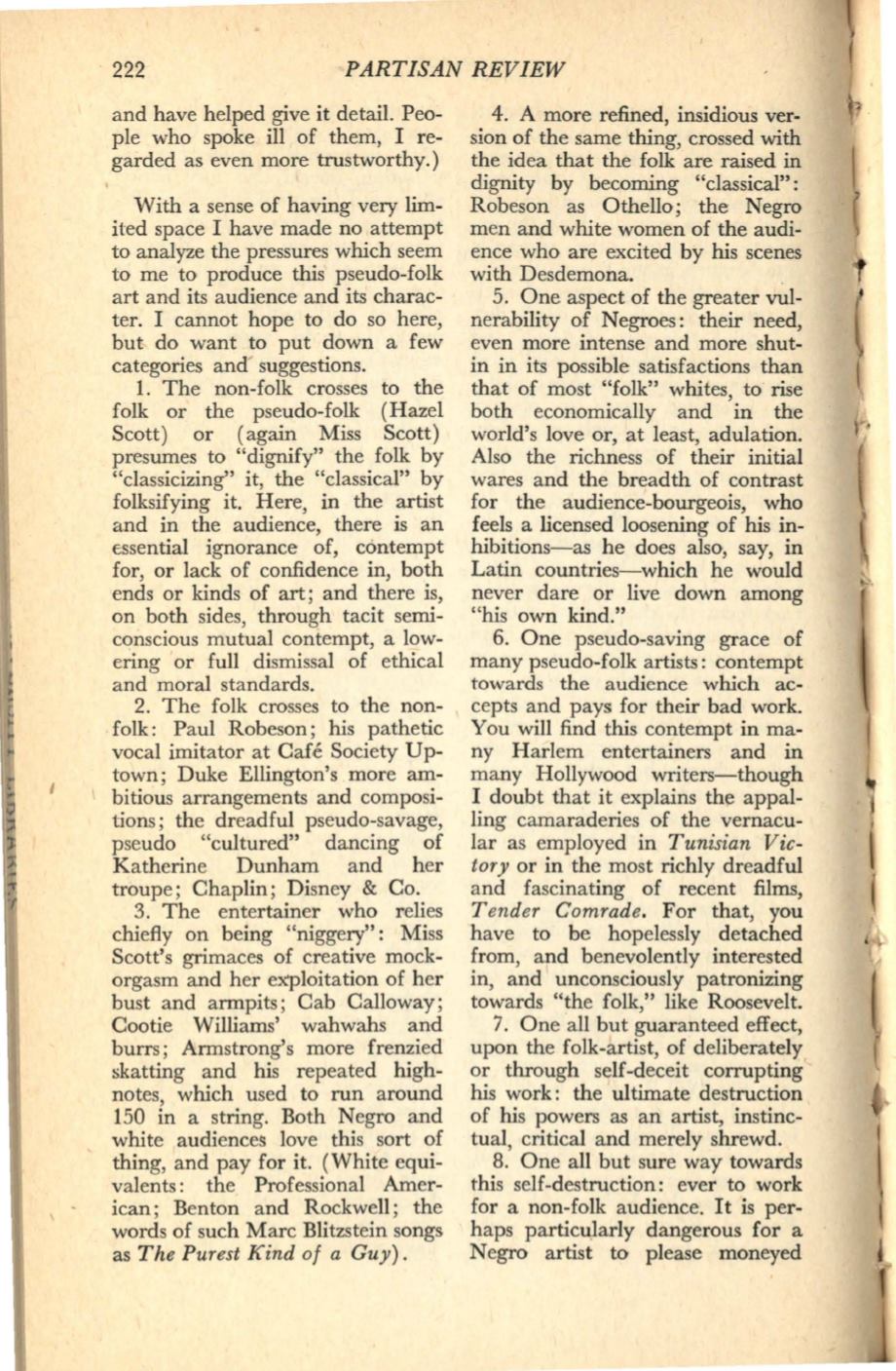
222
PARTISAN REVIEW
and have helped give it detail. Peo–
ple who spoke
ill
of them, I re–
garded as even more trustworthy.)
With a sense of having very lim–
ited space I have made no attempt
to analyze the pressures which seem
to me to produce this pseudo-folk
art and its audience and its charac–
ter. I cannot hope to do so here,
but do want to put down a few
categories and suggestions.
1.
The non-folk crosses to the
folk or the pseudo-folk (Hazel
Scott) or (again Miss Scott)
presumes to "dignify" the folk by
"classicizing" it, the "classical" by
folksifying it. Here, in the artist
and in the audience, there is an
essential ignorance of, contempt
for, or lack of confidence in, both
ends or kinds of
art;
and there is,
on both sides, through tacit semi–
conscious mutual contempt, a low–
ering or full dismissal of ethical
and moral standards.
2. The folk crosses to the non–
folk : Paul Robeson; his pathetic
vocal imitator at Cafe Society Up–
town; Duke Ellington's more am–
bitious arrangements and composi–
tions; the dreadful pseudo-savage,
pseudo "cultured" dancing of
Katherine Dunham and her
troupe; Chaplin; Disney
&
Co.
3.
The entertainer who relies
chiefly on being "niggery" : Miss
Scott's grimaces of creative mock–
orgasm and her exploitation of her
bust and armpits; Cab Calloway;
Cootie Williams' wahwahs and
burrs; Armstrong's more frenzied
skatting and his repeated high–
notes, which used to run around
150
in a string. Both Negro and
white audiences love this sort of
thing, and pay for it. (White equi–
valents: the Professional Amer–
ican; Benton and Rockwell; the
words of such Marc Blitzstein songs
as
The Purest Kind of a Guy).
4.
A more refined, insidious ver–
sion of the same thing, crossed with
the idea that the folk are raised in
dignity by becoming "classical":
Robeson as Othello; the Negro
men and white women of the audi–
ence who are excited by his scenes
with Desdemona.
5.
One aspect of the greater vul–
nerability of Negroes: their need,
even more intense and more shut–
in in its possible satisfactions than
that of most "folk" whites, to rise
both economically and in the
world's love or, at least, adulation.
Also the richness of their initial
wares and the breadth of contrast
for the audience-bourgeois, who
feels a licensed loosening of his in–
hibitions-as he does also, say, in
Latin countries-which he would
never dare or live down among
"his own kind."
6.
One pseudo-saving grace of
many pseudo-folk artists: contempt
towards the audience which ac–
cepts and pays for their bad work.
You will find this contempt in ma–
ny Harlem entertainers and
in
many Hollywood writers-though
I doubt that it explains the appal–
ling camaraderies of the vernacu–
lar as employed in
Tunisian Vic–
tory
or in the most richly dreadful
and fascinating of recent films,
Tender Comrade.
For that, you
have to be hopelessly detached
from, and benevolently interested
in, and unconsciously patronizing
towards "the folk," like Roosevelt.
7.
One all but guaranteed effect,
upon the folk-artist, of deliberately
or through self-deceit corrupting
his work: the ultimate destruction
of his powers as an artist, instinc–
tual, critical and merely shrewd.
8. One all but sure way towards
this self-destruction: ever to work
for a non-folk audience. It is per–
haps particularly dangerous for a
Negro artist to please moneyed


